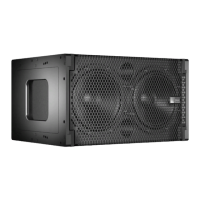M1D Rigging Grids and Accessories
PN: 05.115.001.01 B
Page 3 of 24
Meyer Sound Laboratories Inc.
www.meyersound.com
T: +1 510 486.1166
F: +1 510 486.8356
1. GENERAL INFORMATION
SAFETY STATEMENT
Please read this Statement carefully and in its entirety. It contains important information regarding safety issues,
including guidelines for general safe use of rigging systems as well as advisories on government regulations and
liability laws.
SCOPE OF THIS MANUAL
Although this manual contains much useful information on rigging in general, it does not claim to be a comprehensive
resource on the subject. This manual assumes that the owners and/or users of a QuickFly system are knowledgeable
and experienced in the areas of rigging and ying loudspeaker systems. MANY ISSUES OF CRUCIAL CONCERN,
SUCH AS THE DETERMINATION OF APPROPRIATENESS AND CONDITION OF VENUE RIGGING POINTS, CANNOT
BE ADDRESSED HERE. THEREFORE, THE USER MUST ASSUME ALL RESPONSIBILITY FOR THE APPROPRIATE
USE OF QUICKFLY SYSTEMS IN ANY PARTICULAR LOCATION OR CIRCUMSTANCE.
The suspension of large, heavy objects in public places is subject to numerous laws and regulations at the national/
federal, state/provincial, and local levels. This manual does not address the specics of any such applicable laws and
government regulations. This manual details procedures and practices consistent with those generally acknowledged
as allowable and safe in the United States. However, the user must assume responsibility for making sure that use of
any QuickFly system and its components in any particular circumstance or venue conforms to all applicable laws and
regulations in force at the time.
LOAD RATINGS AND SPECIFICATIONS
Long-term safe operation is a central concern in the design and manufacture of any rigging/ying system. Meyer
Sound has taken great care in material selection and component design. In all critical cases, load points are redundant,
with a safety margin that allows one or more load points to fail while maintaining system integrity. After manufacture, all
load-critical system components are individually inspected.
All load ratings and other specications given in this manual are the result of accepted engineering practice and careful
testing. However, such specications and ratings are subject to change. USERS SHOULD CHECK THE QUICKFLY
SECTION OF THE MEYER SOUND WEBSITE AT
http://www.meyersound.com
OR CONTACT TECHNICAL SUPPORT AT REGULAR INTERVALS TO CHECK FOR UPDATED OR REVISED
INFORMATION.
REGULATORY COMPLIANCE
The design and safe working load (SWL) ratings of the QuickFly system are intended to be in compliance with all
known regulatory statutes currently applicable in the United States. Unless otherwise specied, all working loads are
based on either a 5:1 or 7:1 safety factor. However, as noted above, there are wide variations internationally in the
regulations and practices applying to suspension of sound systems in public places. Although regulations in the United
States are generally among the most stringent, safety codes may be even stricter in a few localities (such as those
highly prone to earthquakes). In addition, applicable safety codes are open to interpretation: Government ofcials
in one location may have a stricter interpretation than another local ofcial, even when operating under the same
regulations and in the same legal jurisdiction.
CONSEQUENTLY, USERS OF QUICKFLY RIGGING SYSTEMS SHOULD BE PREPARED TO TAKE ADDITIONAL
SAFETY ASSURANCE MEASURES BEYOND THOSE OUTLINED IN THIS MANUAL. IN ALL CASES, IT IS THE
RESPONSIBILITY OF THE USER TO MAKE CERTAIN THAT ANY MEYER SOUND LOUDSPEAKER SYSTEM IS
SUSPENDED IN ACCORDANCE WITH ALL APPLICABLE NATIONAL/FEDERAL, STATE/PROVINCIAL, AND LOCAL
REGULATIONS.

